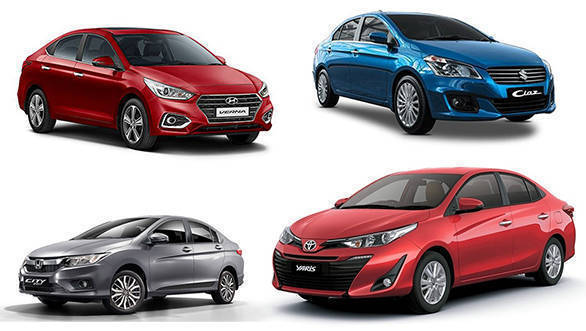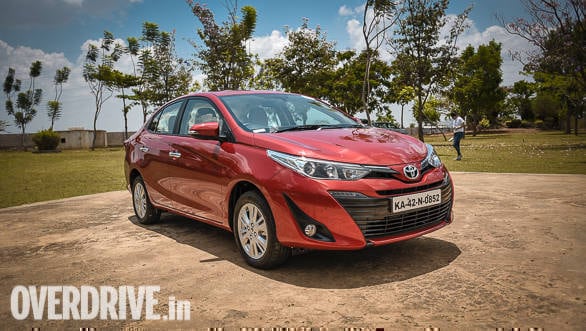Spec comparison: Toyota Yaris vs Honda City vs Hyundai Verna vs Maruti Suzuki Ciaz
Toyota has launched the Yaris sedan in India at an introductory price of Rs 8.75 lakh, ex-showroom India. This premium offering from Toyota is available in four variants. And what makes the deal really impressive is the fact that all the variants from base to the top-spec can be optioned with an automatic transmission. The Toyota Yaris competes with the likes of the Honda City and the Hyundai Verna in India in the top end B segment space. The Honda City got an update in the form of a revised design and addition of more features in 2017 while the new-gen Hyundai Verna was launched earlier this year. And lastly, the Maruti Suzuki Ciaz sedan that occupies an important place in this segment.

The Toyota Yaris is well-proportioned with some nicely designed elements like the long and slim headlamps and slender front grille, with the equally thin LED DRLs placed on both sides. In contrast are the massive air vents in the bumper. However, the Yaris like several other Toyotas is rather conservatively styled and does not have the flamboyance or eye-catching looks that many Indian consumers are known to like. Given this, it remains to be seen how well it is accepted by people once it starts rolling out of showrooms.

The body structure of the Hyundai Verna is made of 50 per cent high strength steel making it safer than before. The larger hexagonal grille sits proudly at the front, which is partnered by projector headlamps and fog lamps on either side. The Verna also sports a coupe-like silhouette with the roof merging into a smaller boot lid. The wrap-around tail-lamp now incorporate the 3-LED design for the stop-lamps and are a prominent part of the rear end. The rear bumper gets the two-tone treatment.
The City takes the "ain't broken-don't fix it". The Honda City is one handsome car. Proper three-box proportion with the right amount of modernisation thrown into the mix gives the City a classy appeal which is on point with its position as the segment-leader. The recent update including the addition of all LED lamps - front and rear, along with bigger diamond-cut smoked alloys have given it a sharper and sportier persona, which it seemed to lack.
Compared to the other two, the Maruti Suzuki Ciaz looks a bit dated. It is not something that would turn heads, but it definitely won't go unnoticed. It appears long and wide and has quite a presence. If it were up to us, we'd say it is very much 'inspired' by the City, especially the rear end. The projector headlamps, wide tail lamps and generous yet apt use of chrome do impart to it an air of quality. An updated Ciaz is on its way soon though.
InteriorThe Toyota Yaris is somewhat smaller in size than its main rivals and while a direct back to back comparison in future will establish if this also translates into less space in the cabin, the initial impression is that the passenger compartment is not as spacious. But to its credit, the Yaris's interior looks bright and inviting and is very sensibly laid out. Everything falls to hand easily and all instruments and dials and switches are effortless to read and operate.
A well-balanced two-toned theme dominates the Hyundai Verna's cabin. The dash is functional and tidy with everything ever so slightly inclined toward the driver. The instrument cluster is as good as it gets with a colour MID housed between the dials. The leather-wrapped steering has an array of controls which are easy to distinguish and operate, including cruise control. Storage spaces are ample throughout the cabin, including a cooled glove box. Boot space is a substantial 480 liters, which is 30 liters less than that of both the City and the Ciaz. However, it can be opened by waving your foot underneath the bumper. Latest to the cabin is an all new electric sunroof and cooled front seats. On the safety front, the top spec model gets six airbags, along with the usual ABS and EBD systems.
Honda has taken a bold step and gotten rid of as many switches and knobs as it can from the City's cabin. The dash is all touch-controls based. Be it the AC or media functions, everything has a touch operated interface. Of course, there is a touchscreen as well. The dash is all black with generous use of piano black inserts. The boot is an impressive 510 liters. The City offers an electric sunroof for the top trim as well, along with six airbags.
6.9-inch screen looks larger with its design and black surrounds
Maruti-Suzuki, on the other hand, employed the pure-business-no-nonsense approach to the Ciaz. The interior is nicely laid out, with the touchscreen Smartplay system sitting at the center. The cabin is themed two-tone, as is with the City and Verna, except for the top trim which comes with an all-black upholstery. The instrument cluster has clear and easy-to-read dials, with a monochromatic MID between them. The Ciaz has the same sized boot as the City at 510 liters. Where the Ciaz fall behind is at offering just two airbags, even in the top trim.
range
Engines
The Verna has the 1.6-litre Gamma VTVT petrol and 1.6-litre U2 CRDi diesel engine carried over from the outgoing cark. The figures are 123PS@6,400rpm and 154Nm@4,850rpm for petrol and 128PS@4,000rpm and 265Nm@1,500rpm for the diesel. Hyundai has tuned both the engines to produce higher torque at much lower revs than before. Both the engines come mated to either a 6-speed manual or a 6-speed auto gearbox.
The City comes with the 1.5-litre i-VTEC or Honda's first ever diesel 1.5-litre i-DTEC motor. The petrol outputs 119PS@6,600rpm and 145Nm@4,600rpm while the diesel churns out 100PS@3,600 and 200Nm@1,750rpm. The petrol is coupled with either the 5-speed manual or a CVT while the diesel gets a 6-speed manual.
The Fiat-sourced 1.3 litre DDiS diesel with Smart Hybrid technology does duty in Ciaz's diesel variants. The motor churns out 90PS@4,000rpm and 200Nm@1,750rpm. It is mated to a 5-speed manual transmission. The petrol variants get the 1.4 litre VVT petrol engine which delivers 93PS@6,000rpm and 130Nm@4,000rpm. However, the petrol is offered with a choice of 5-speed manual or 4-speed automatic transmission.
For now Toyota is only offering the Yaris with a 1.5-litre VVT-i petrol engine generating 107PS and 140 Nm of torque. Most of its rivals have the option of both petrol and diesel engines, so the Yaris may lose out because of this. The fact that its petrol unit is less powerful than the ones in the Hyundai Verna (1.6 L and 125 PS) and Honda City (1.5 L and 120PS), will also not aid matters much.
Price
In the comparison table below, we have taken the top spec variants of all the sedans. The Toyota Yaris is the most premium offering at Rs 12.85 lakh for the manual and Rs 14.07 lakh for the automatic. This is then followed by the Honda City at Rs 11.83 lakh, Hyundai Verna at Rs 11.41 lakh and lastly the Maruti Suzuki Ciaz at Rs 9.48 lakh, all manual transmission models. Similar is the case with automatics as well. The table below will give an idea of where these sedans stand against each other. While a real-world comparison between these sedans is expected to happen shortly, let us know your favorite in the comments section below.